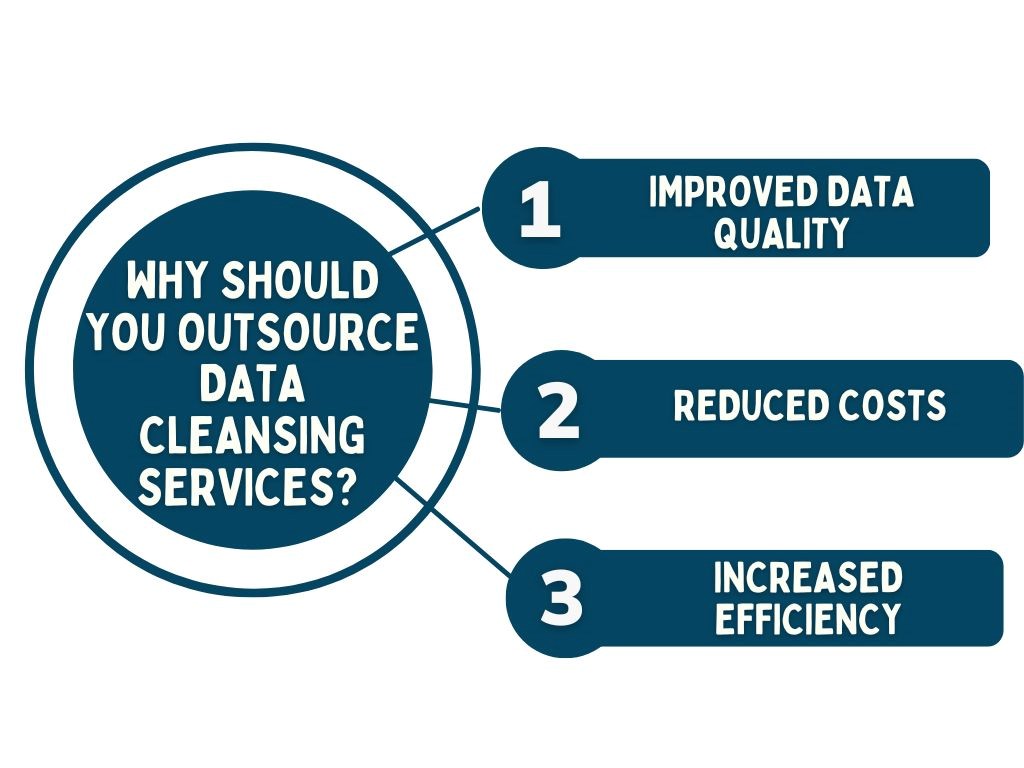Why is Data Cleansing Critical to your Business in 2023?

Any company’s data is important, but if it’s not handled properly, it can become a liability for the organization. If you don’t regularly clean and update your data, it becomes outdated, inaccurate, or incomplete. Without updated and accurate data, you cannot make decisions or understand your customers or markets. That’s where data cleansing comes in. It is one of the key steps in data management, which is often overlooked.
Data from customers and other sources is essential to your company’s success. However, it can be difficult to manage this data in-house, as it requires significant time and resources. When you outsource data cleansing services, you just don’t save time and costs but you can also ensure your data is accurate and up-to-date while allowing your staff to focus on other tasks.
In this article, we will look at why data cleansing is so important for a company’s security and success, how outsourcing can help streamline the process and make sure your data is as accurate as possible.
What are the advantages of Data Cleansing to your business?

Data cleansing helps businesses to identify and correct errors in their data. When you have accurate data, you can trust the insights you glean from it. This, in turn, leads to more reliable predictions and an increase in productivity. Here are the advantages of data cleansing to your business’s overall growth:
1. More Precise Perceptions and Trustworthy Predictions
When you have cleansed data, you can be sure that the insights and predictions you make are based on accurate information. This means that you are more likely to make decisions that lead to positive outcomes for your business.
2. Boost Productivity and Effectiveness
Cleansing data can help you to identify and remove errors and inaccuracies that can lead to wasted time and resources. This can help to increase the efficiency and productivity of your team, as well as the overall effectiveness of your business.
3. Lower Costs overall while Boosting Revenue
By cleansing your data regularly, you can avoid the unnecessary costs associated with poor-quality data, such as storage costs, processing fees, and lost opportunities. In addition, cleansed data can help you to improve your marketing efforts, leading to increased revenue.
4. It Raises the Email Campaign’s Return on Investment
One of the key advantages of data cleansing is that it can help to improve the ROI of your email marketing campaigns. By ensuring that your contact lists are accurate and up-to-date, you can avoid wasting time and money sending emails to people who are no longer interested in hearing from you.
5. Boost Client Satisfaction
When customers receive relevant communications from businesses, they are more likely to be satisfied with the service they receive. Data cleansing can help you to target your communications more effectively, leading to happier customers who are more likely to remain loyal to your brand.
Also Read: Things to Know about a Data Center and Server
What are the best techniques for cleaning data?
Data cleansing is a critical step in ensuring that data is accurate and can be used effectively. Several best practices should be followed when cleansing data, including
1. Get Rid of Duplicates
Duplicate data can skew results and lead to inaccuracies. It is important to identify and remove duplicate data before proceeding with any analysis.
2. Delete Pointless Information
Data hygiene is the process of identifying and cleaning up inaccuracies and inconsistencies in data. It is an important part of data analysis, as irrelevant and incorrect data can clutter up a dataset and make it more difficult to work with. There are several data hygiene services available that can help to clean up your data by correcting errors and removing any irrelevant information.
3. Make Capitalization Consistent
Capitalization can affect how data is analyzed and interpreted. All data should be standardized to ensure accuracy.
4. Change the Data Type
Different types of data can be difficult to compare or analyze together. It is important to convert all data to the same type before proceeding with any analysis.
5. Standardized Formatting
Inconsistent or incorrect formatting can make data difficult to work with or interpret accurately. All formatting should be checked and corrected before proceeding with any analysis. To do this, remove any extraneous formatting (e.g., bolding, italics, etc.).
6. Correct the Errors
Errors in data can lead to inaccurate results or conclusions. It is important to identify and correct any errors before proceeding with any analysis.
7. Translation of Languages
Data from different sources may be in different languages. It is important to translate all data into the same language before proceeding with any analysis.
8. Checking the Missing Values
Systematically dealing with missing values can help improve the quality of the dataset as a whole.
What basic steps should you follow to clean the data?
You can establish a plan for your organization by following these fundamental steps, even though the methods used for data cleaning may change depending on the types of data your company stores.
1. Delete any Repetitions or Pointless observations
When you are dealing with a dataset, it is important to remove any duplicate observations that may be present. This can be done by either dropping the duplicates or keeping only the unique values. You should also remove any irrelevant observations that do not add value to your analysis.
2. Correct Structural Issues
Structure errors can make it difficult to analyze the data set and introduce bias, so this is a crucial step. To ensure that your analysis is accurate, some errors in the data structure may need to be fixed.
3. Remove Undesirable Outliers
After that, unwanted outliers should be filtered out. An outlier is an observation that is significantly different from the rest of the data. Outliers can skew results and lead to inaccurate conclusions, so it is important to identify and remove them from the data set.
4. Deal with Missing Data
This step is important to ensure that the data set is as complete as possible. Missing data can make it difficult to find trends and patterns, and can also introduce bias.
5. Verify and Quality Assurance
This step helps to ensure that the results of any analysis are accurate and reliable. The data should be validated to determine whether it supports or contradicts your working theory, as well as whether it makes sense and complies with relevant industry standards and more. This step is important because it helps to ensure that the data meets all of the requirements for its field and that any conclusions drawn from the data are valid.
Why should you Outsource Data Cleansing Services?
Organizations amass large amounts of data over time. This data can be in the form of customer records, financial transactions, supplier information, employee data, and more. Maintaining this data can be challenging to do in-house, especially as it grows in volume and complexity. Data cleansing services can be useful in this situation. Data cleansing services can help organizations maintain their data by identifying and correcting errors, filling in missing values, and standardizing formats. This can be a time-consuming and tedious process, but it is essential for keeping accurate records. Outsourced data cleansing services can provide expert support to help ensure your data is clean and up-to-date. There are many benefits of outsourcing data cleansing services, including

- Improved Data Quality: Data cleansing can improve the overall quality of your data, making it more accurate and up-to-date.
- Reduced Costs: Outsourcing data cleansing can save you time and money by reducing the need for internal resources.
- Increased Efficiency: Data cleansing can help you streamline your processes and workflows, making them more efficient.
Take Away
Before starting your analysis, it’s critical to ensure that the data you’re working with is clean. Data that is “dirty” can cause a wide range of problems, so you want it to be clean before you start working with it. There are a few different approaches to data cleaning, and the most effective one will depend on your particular requirements. You can either do it yourself or have a data cleansing company do it for you.
On the other hand, hiring database cleanup services can save you time and hassle. A good data cleansing service will have the experience and expertise necessary to quickly and effectively clean your data. In addition, these services specialize in identifying and correcting errors in databases, so they’ll be able to get your data into shape quickly and efficiently.
Author Bio
Gracie Ben is a data analyst currently working at DataEntryIndia.in, a leading company providing data entry & mining services & other data-related solutions. For more than ten years, she has actively contributed to the growth of many enterprises & businesses (startups, SMEs, and big companies) by guiding them to utilize their data assets. Having a keen interest in data science, Gracie keeps herself up-to-date on all the latest data trends and technologies shaping the industry and transforming businesses. She has written over 1600 articles and informative blogs so far covering various topics, including data entry, data management, data mining, web research, and more.
Also Read: How Can You Prevent Data Breach in Your Organization




